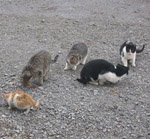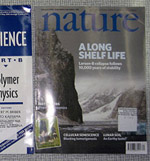Study tracks salmon farm escapees
 Fish,
Fish,  Freshwater,
Freshwater,  Marine
Marine  Atlantic Salmon. Photo taken through the glass in Atlanterhavsparken, Ålesund, Norway. Image credit, Hans-Petter Fjeld.Where do salmon go when they escape from fish farms? A new study and Lars Peter Hansen and Alan Youngson try to answer this question for farmed Atlantic salmon (Salmo salar L.) from Scotland and Norway.
Atlantic Salmon. Photo taken through the glass in Atlanterhavsparken, Ålesund, Norway. Image credit, Hans-Petter Fjeld.Where do salmon go when they escape from fish farms? A new study and Lars Peter Hansen and Alan Youngson try to answer this question for farmed Atlantic salmon (Salmo salar L.) from Scotland and Norway.
The researchers tagged and experimentally released 678 farmed fish in Scotland and 597 farmed fish in Norway. Only a small percentage of the fish were recovered by fishermen and reported to the researchers (.6% of the Scottish fish and 7% of the Norwegian fish).
However, the Scottish fish that were caught had travelled very far - up to 1600 kilometers from the release site - and all dispersed to the east towards Scandinavia. Meanwhile, the Norwegian farmed salmon released were mostly recaptured by fishermen in local waters - 27 in freshwater and 15 in sea - within 150 kilometers of the release site.
According to the authors, salmon farm escapees are common in North Atlantic waters and can cause a number of potential problems:
- High numbers of salmon escapees may complicate the assessment and management of wild salmon stocks.
- Research has shown that interbreeding between wild and farmed salmon may reduce the fitness of wild populations.
- Farmed salmon escapees may act as vectors for disease and parasites to wild salmon.
Figuring out the dispersal patterns of escapees is an important step in better understanding and addressing the problem. The study authors propose a number of hypotheses to explain the observed dispersal patterns in the study.
One especially interesting hypothesis to explain the easterly bias towards Scandinavia in all fish recaptured including those from Scotland, the authors speculate that this may be due to the dominance of Norwegian broodstock in the existing strains of European aquaculture.
--Reviewed by Rob Goldstein
HANSEN, L., & YOUNGSON, A. (2010). Dispersal of large farmed Atlantic salmon, , from simulated escapes at fish farms in Norway and Scotland Fisheries Management and Ecology, 17 (1), 28-32 DOI: 10.1111/j.1365-2400.2009.00709.x




Reader Comments